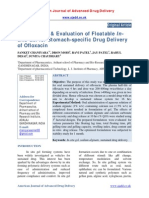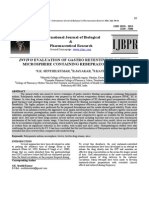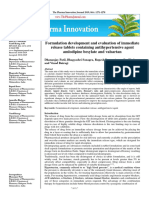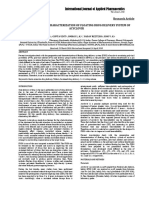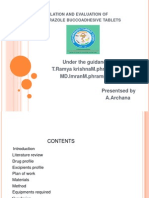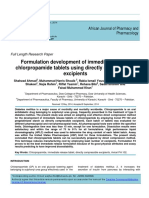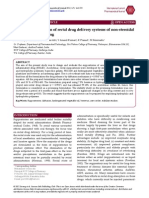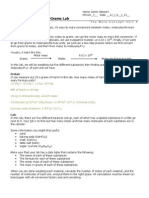In Vitro Absorption Studies of Acyclovir
In Vitro Absorption Studies of Acyclovir
Uploaded by
Kailas MaliCopyright:
Available Formats
In Vitro Absorption Studies of Acyclovir
In Vitro Absorption Studies of Acyclovir
Uploaded by
Kailas MaliOriginal Description:
Copyright
Available Formats
Share this document
Did you find this document useful?
Is this content inappropriate?
Copyright:
Available Formats
In Vitro Absorption Studies of Acyclovir
In Vitro Absorption Studies of Acyclovir
Uploaded by
Kailas MaliCopyright:
Available Formats
Latin American Journal of Pharmacy (formerly Acta Farmacutica Bonaerense) Lat. Am. J. Pharm.
29 (8): 1411-8 (2010)
Original Article Received: January 22, 2010 Revised version: April 13, 2010 Accepted: April 16, 2010
In Vitro Absorption Studies of Acyclovir Using Natural Permeation Enhancers
Remeth J. DIAS*, Kailas K. MALI, Vishwajeet S. GHORPADE, Sandeep B. GARJE, & Vijay D. HAVALDAR Department of Pharmaceutics, Satara College of Pharmacy, India Plot no. 1539, New Additional M.I.D.C., Behind Spicer India Ltd. Degaon, Satara-415004, India
SUMMARY. Gastroretentive Delivery Systems are employed to improve the bioavailability of drugs which are absorbed through upper part of GIT, by increasing their retention time. Incorporation of permeability enhancers in the formulations of such drugs can further increase their bioavailability; however their use in the formulations is questionable due to the toxicity exhibited by them. Acyclovir is a class III drug having low oral bioavailability due to improper absorption. Mucoadhesive tablets of acyclovir containing natural permeation enhancers were prepared by direct compression and evaluated for mucoadhesion strength, in-vitro dissolution parameters and in-vitro absorption studies. The formulations containing Aloe vera extract showed increase in the mucoadhesion strength and retarded the drug release. The in-vitro absorption studies revealed that the formulations containing Aloe vera extract (Enhancement Ratio 1.94) and chausath prahar pippal (Enhancement Ratio 1.87) showed significant increase in the permeation of the drug. The studies led to the conclusion that by formulating mucoadhesive tablets of acyclovir containing natural permeation enhancers increased the permeability, thus proving to be the cheaper and easily available alternative to the other permeation enhancers.
INTRODUCTION Acyclovir, 9-(2-hydroxyethoxylmethyl) guanine, is used in the treatment of disease caused by herpes simplex virus (HSV) and varicella zoster virus. According to the Biopharmaceutical Classification System, acyclovir is categorized as class-III drug i.e. having high solubility and less permeability 1. Acyclovir has narrow absorption window in gastrointestinal tract (GIT) due to erratic absorption. Therefore, the average bioavailability of acyclovir is about 10 % to 20 %. Repeated administration of high dose of acyclovir is required for effective treatment. Normal dosage regimen of acyclovir in case of genital HSV infection is 200 mg 5 times/day and herpes zoster infection is 800 mg 5 times per day 2. Prolonging the gastric retention of a delivery system is sometimes desirable for achieving therapeutic benefit of drugs that are absorbed
from the proximal part of the GIT or that are less soluble in or are degraded by the alkaline pH in the lower part of GIT. Gastroretentive delivery systems (GRDSs) are thus beneficial for such drugs by improving their bioavailability, therapeutic efficacy and by possible reduction of dose 3. The permeability of drug candidates across the gastrointestinal mucosa is one of the most critical factors in defining drug bioavailability and biological activity 4. The permeation enhancers such as sodium lauryl sulphate, sodium deoxycholate, dimethyl sulfoxide (DMSO) are mostly used to enhance the penetration of the drugs having low permeability 5. The increase in the permeability of acyclovir from the mucoadhesive tablet containing sodium lauryl sulphate has been reported 6. However, due to certain toxic effects, such as irritation of the mucous
KEY WORDS: Acyclovir, Aloe vera, Chausath prahar pippa, Natural permeation enhancer.
* Author to whom correspondence should be addressed. E-mail: rjdias75@rediffmail.com
ISSN 0326-2383
1411
DIAS R.J., MALI K.K., GHORPADE V.S., GARJE S.B. & HAVALDAR V.D.
membrane, and costlier nature of these permeation enhancers, there is need of natural permeation enhancers which are cheaper and easily available. Yajaman S. et al. 7 have reported the use of methanol solid precipitate of Aloe vera as permeation enhancer. Certain ayurvedic preparations like chausath prahar pippal and rassindhur have been found to alter the membrane characteristics and thus may increase the permeability of drugs. These natural permeation enhancers are easily available at low cost and are non-toxic at specific range of concentration 8-13. In the present work, attempts are made in order to increase the rate and extent of absorption of acyclovir by retention of drug in GIT for longer duration and to improve the permeability using natural permeation enhancers. The current investigation aims at developing mucoadhesive drug delivery system of acyclovir containing natural permeation enhancers and studying the effect of chausath prahar pippal, rassindhur and methanolic extract of Aloe vera on permeability of acyclovir. MATERIALS AND METHODS Materials Acyclovir was provided ex gratis by FDC (Mumbai, India), Carbopol-934P (CP) was procured from Rajesh Chemicals Pvt. Ltd (Mumbai, India), HPMC K100M was gifted by FDC (Mumbai, India), Rassindhur and Chausath prahar pippal were provided by Aryangla Ayurvedic Mahavidyalaya (Satara, India), Aloe vera juice was provided by Ayurkisan Herbals (Baramati, India). All other chemicals employed were of analytical grade. Preparation of mucoadhesive tablets with natural permeation enhancers The prepared formulations consisted of acy-
clovir as the proposed drug with HPMC K100M and carbopol-934P as the rate controlling polymers. The amount of polymers and other excipients was decided on the basis of preformulation studies. Chausath prahar pippal, rassindhur and methanolic extract of Aloe vera were used as natural permeation enhancers in optimized concentration. Dibasic calcium phosphate was added as pore forming agent while spray dried lactose as a diluent, with fixed quantity of talc as lubricant. Drug and the excipients were homogeneously blended and subsequently compressed into flat-faced tablets (10 mm diameter) using single punch tablet compression machine. A formulation without natural permeation enhancer was prepared for comparing the mucoadhesion, drug release and drug permeability of the other formulations with it. The detailed compositions of each formulation are given in Table 1. Evaluation of formulations with natural permeation enhancers Drug content Five tablets from each formulation were powdered individually and a quantity equivalent to 100 mg of Acyclovir was accurately weighed and extracted with suitable volume of 0.1 N HCl. Each extract was suitably diluted and analyzed spectrophotometrically at 254 nm 14. Physical evaluation Twenty tablets from each batch were evaluated for uniformity in tablet weight and thickness. Since the tablet weight is 450 mg, 14 tablets from each formulation were examined for friability using Roche-type friabilator (Lab Hosp.) and 6 tablets from each formulation were examined for hardness using Monsantotype hardness tester.
Ingredient (mg)
F1
F2
F3
F4
Acyclovir Carbopol 934 HPMC K100M MCC DCP Talc Rassindhur (ardhagandhakajarit) Aloe vera Chausath prahar pippal Total weight
200 34 70 25 17.5 3.5 350
200 44 90 9 22.5 4.5 80 450
200 44 90 9 22.5 4.5 80 450
200 44 90 9 22.5 4.5 80 450
Table 1. Formulation of mucoadhesive tablets containing optimized concentration of natural permeation enhancers.
1412
Latin American Journal of Pharmacy - 29 (8) - 2010
Ex vivo mucoadhesion studies The working of a double beam physical balance formed the basis of the bio-adhesion test apparatus fabricated (Fig. 1). The right pan of a physical balance was removed and was replaced with a steel cylinder hanged with a lightweight thread. The height of this total setup was adjusted to accommodate a glass container below it, leaving a head space of about 0.5 cm in between, a steel block was fabricated with an upward protrusion on one of its face. This was kept inside the glass container, which was then placed below the right hand setup of the balance. The two sides were then balanced. The sheep mucus membrane was excised and washed (equilibrated at 37 1 C for 30 min in phosphate buffer saline medium before the mucoadhesion evaluation study) and tied tightly with the mucosal side upwards using a thread over the protrusion in the steel block. The block was then lowered into the glass container, which was then filled with isotonic phosphate buffer kept at 37 1 C such that the buffer just reaches the surface of mucosal membrane and keeps it moist. This was then kept below the right hand setup of the balance. The tablet was then stuck to the cylinder using cyanoacrylate glue and the balance beam raised, a constant weight of 10 g for total contact period of 5 min was placed over the steel block. Bioadhesive strength was then assessed by adding weights on the left pan till the tablet separated from the mucosal surface, in terms of
weight in gm required to detach tablet from membrane 15,16. Compatibility studies An IR spectrum of acyclovir and formulations containing natural permeation enhancers was recorded to study the interaction between drug and natural permeation enhancers. The pellet was prepared in KBr press using mixture of drug and natural permeation enhancers (1:1 proportion) along with KBr in ~ 1:10 ratio. The spectrum was recorded over the wavenumber of 4000 to 400 cm1. In vitro drug release studies Dissolution studies were performed for all the formulation combinations, in triplicate, employing United States Pharmacopoeia (USP)-23 paddle method (Electrolab, TDT-06P Mumbai) and 0.1N HCl as the dissolution medium at 50 rpm and 37 0.5 C. An aliquot (0.5 mL) of the sample was withdrawn periodically at suitable time intervals and the volume was replaced with an equivalent amount of the plain dissolution medium. The samples were analyzed spectrophotometrically at 254 nm 17. In-vitro absorption studies of formulation A continuous dissolution-absorption system was designed in order to conduct in vitro absorption studies of the pure drug, marketed formulation and mucoadhesive formulations with and without natural permeation enhancers. The system consisted of USP Dissolution Apparatus Type I and a side-by-side perfusion apparatus with isolated everted intestine segment. In this system, drug dissolution from the tablet and permeation across everted intestine occurred simultaneously. The dissolution medium used was 900 ml (phosphate buffer pH 5.0) maintained at 37 0.5 C. The perfusion apparatus consisted of two glass tubes, A and B, connected together. Tube B had a bent cannula at its lower end, and tube A had a straight cannula at its lower end. The isolated everted intestinal segment of chicken was fixed between the ends of tubes A and B as shown in the Figure 2. The ends of the intestine were tied in position with a thread. The apparatus was immersed completely into the dissolution vessel 18. The dissolution medium consisted of 900 ml phosphate buffer pH 5.0 maintained at 37 C. A fresh intestinal segment was clamped to the perfusion apparatus. The total volume of the absorption compartment (tube A and tube B of
Figure 1. Modified analytical balance for mucoadhesion test.
1413
DIAS R.J., MALI K.K., GHORPADE V.S., GARJE S.B. & HAVALDAR V.D.
posed area of the tissue and C0 is the initial concentration of the drug in the donor compartment 19. The enhancement ratio was calculated by according to the following equation: Enhancement ratio (ER) = Permeability coefficient of drug with natural permeation enhancers / Permeability coefficient of pure drug. Stability studies Accelerated stability studies were carried out on all formulations according to ICH guidelines 20 . 45 tablets from each formulation were wrapped in aluminum foils and then placed in respective amber colored bottles. The formulations were stored at 40 C/75 % RH in stability chamber. The tablets were evaluated for hardness, friability, mucoadhesion, drug content, in vitro drug release and in vitro absorption after 0, 3 and 6 months. RESULTS AND DISCUSSION Preparation of formulations The addition of natural permeation enhancers into the formulations led to the loss of matrix integrity of the tablets. In order to overcome this problem, the amount of polymers and other excipients were readjusted in formulations F2, F3 and F4. Drug content Drug content of formulations was found to be in the range of 97.30 to 98.49 % (Table 2). The results showed no interference of natural permeation enhancers i.e. chausath prahar pippal, rassindhur and methanolic extract of Aloe vera. Physical evaluation The weights of all tablets were within 5 % of the average weight. The thickness was found between 2.92 and 2.94 mm, and hardness between 6.33 and 7.66 kg/cm2 (Table 2). Friability was found to be in between 0.57 and 0.65 %. Thus, all the physical parameters of the compressed tablets were practically within control. Ex-vivo mucoadhesion studies Table 2 shows mucoadhesive strength of all the formulations. It was found that formulation containing Aloe vera extract showed significant increase in mucoadhesive strength (p < 0.05). This may be due to presence of mucoadhesive polysaccharides in Aloe vera. Formulations containing rassindhur and chausath prahar pippal
Figure 2. Continuous dissolutionabsorption system using isolated everted intestine system. I: USP Dissolution apparatus (Type I); II: Perfusion apparatus: 1: dissolution vessel; 2: rotating shaft; 3: lid; 4: basket; 5: formulation; 6: aeration tube; 7: tube B of perfusion apparatus; 8: tube A of perfusion apparatus; 9: isolated everted intestinal segment.
perfusion apparatus) consisted of Krebs ringer solution. The tablet was transferred to the dissolution basket of the designed system and rotated at 50 rpm. Dissolution samples (0.5 ml) were withdrawn at predetermined time intervals i.e. 15, 30, 45, 60, 75, 90, 105 and 120 min upto 2 h. The transported drug from the absorption compartment was sampled with replacement at 18, 33, 48, 63, 78, 93, 108 and 123 min and samples were analyzed spectrophotometrically at 254 nm. Absorption samples of formulated tablets were collected 3 min later than the corresponding dissolution samples to allow the drug to permeate the everted intestinal membrane. The whole experiment was repeated in triplicate using fresh dissolution medium as well as fresh intestinal segment. The apparent permeability coefficient (Papp) of the tablets was calculated from the linear portion of a plot of the total amount of drug transported versus time, and determining the slope of the straight line. The Papp (cm/sec) of the drug across the intestinal mucosa was calculated according to the followint equation : Papp(cm/sec)= (dQ/dt )/(A X 60 X C0), where dQ/dt is the steady state appearance rate (mg/min) namely the amount of a compound traversing the tissue in time t (min), A is the ex-
1414
Latin American Journal of Pharmacy - 29 (8) - 2010
Formulation
Thickness (mm) n = 20
Hardness (kg/cm2); n = 6
Friability (%); n = 14
Drug Content (%)
Mucoadhesive Strength; n = 3
F1 F2 F3 F4
2.63 2.932 2.920 2.942
0.01 0.017 0.018 0.014
6.33 9.66 7 6.33
1.00 0.57 2.08 1.52
0.56 0.59 0.65 0.57
99.05 98.49 97.45 97.30
19.66 21.66 24.33 21.5
0.57 1.52 1 0.7
Table 2. Physical evaluation of prepared formulations.
Figure 3. Bar chart showing the values of mucoadhesive strength of all formulations. F1 : Formulation without natural permeation enhancers; F2: Formulation containing Rassindhur; F3: Formulation containing Aloe vera extract; F4 : Formulation containing
Chausath prahar pippal.
Figure 4. IR spectra of acyclovir and formulations. A: acyclovir (pure drug), B: acyclovir formulation, C: formulation containing Aloe vera, D: formulation containing Rassindhur, E : IR formulation containing chausath prahari pippal.
showed non significant increase in the mucoadhesive strength. This may be due to absence or presence of any kind of constituent present in rassindhur and chausath prahar pippal. There is need of investigation in case of rassindhur and chausath prahar pippal to find out their impact on mucoadhesion. Figure 3 shows the bar chart depicting significant variation in the value of mucoadhesive strength of formulation containing Aloe vera extract as compared to other formulations. Compatibility studies Figure 4 shows the IR spectra of acyclovir and formulations containing natural permeation enhancers. The IR spectrum of acyclovir shows principal absorption peaks at 3500 cm1(OH), 1695 cm 1 (C=O), 3282 cm 1 (NH 2 ), 1487 cm1(C=N) and 1185 cm1(CN). On comparing the IR spectra of acyclovir and formulations containing natural permeation enhancers, it was found that IR spectra of formulations containing natural permeation enhancers showed all the characteristic absorption peaks of acyclovir which gave an evidence that there is no any unusual interaction between acyclovir, natural permeation enhancers and other excipients.
In vitro drug release studies The dissolution profile of all formulations is shown in Figure 5. Dissolution studies were carried out for 12 h. It was observed that in case of formulations containing Aloe vera extract, drug
Figure 5. In vitro dissolution release profile of mucoadhesive tablets containing natural permeation enhancers: F1 ( ), F2 ( ), F3 ( ) and F4 ( ).
1415
DIAS R.J., MALI K.K., GHORPADE V.S., GARJE S.B. & HAVALDAR V.D.
release was retarded than the other formulations. It may be due to presence of mucopolysaccharides such as xylose, arabinose which have the drug release retardant property 3. In case of formulations containing rassindhur and chausath prahar pippal, a negligible effect on drug release was observed. Kinetic studies revealed that formulations containing natural permeation enhancers followed non fickian diffusion (n = 0.4640-0.5330). In vitro absorption studies It was found that there was no any prominent improvement in the permeability of acyclovir from the mucoadhesive formulations without permeation enhancer, when compared to pure drug. In case of marketed tablet (ACIVIR), permeability of acyclovir was found to be more than that of pure drug, formulation without permeation enhancer and formulation containing rassindhur which may be due to fast dissolution of acyclovir from conventional tablet or due to presence of some unknown permeation enhancers in the tablet. It has been found that attachment of thiol group to the chitosan increases the permeability of acyclovir 21. However rassindhur containing formulation didnt show much increase in the permeation of acyclovir, though it contained mercury and sulphur as permeation enhancers 10. The formulation containing chausath prahar pippal and Aloe vera showed significant increase (p < 0.01) in the permeability of acyclovir as compared to that of pure drug, marketed formulation and other mucoadhesive formulations. The enhancement ratio of formulation containing chausath prahar pippal (1.87) and Aloe vera (1.94) was higher than marketed formulation (1.16), formulation without permeation enhancer (1.04) and formulation containing rassindhur (1.13). Chausath prahar pippal is prepared from Piper nigrum L. and Piper longum L. which contain piperines. Piperines are known to possess bioavailability enhancing property 9,12. The increase in the permeability of formulation containing chausath prahar pippal may be due to presence of piperines. Aloe vera gel include polysaccharides containing glucose, mannose, galactose, xylose, arabinose, tannins, steroids, organic acids, antibiotics, glucorinic acid, enzymes, trace sugars, calcium oxalate, a protein containing 18 amino acids, wound healing hormone, biogenic stimulator, saponin, vitamins, chloride, sulphate, iron, calcium copper, sodium, potassium, manganese 22-24. Methanol precipitable solids of Aloe vera
Figure 6. Bar chart showing the values of permeability coefficient of pure drug, marketed formulation and mucoadhesive formulations with and without natural permeation enhancers. F1: Formulation without natural permeation enhancers; F2: Formulation containing Rassindhur; F3: Formulation containing Aloe vera extract; F4: Formulation containing Chausath prahar pippal.
have been used as permeation enhancer in buccal adhesive tablets of diltizem HCl7. There are over 200 constituents, the single most important constituent being the polysaccharides. Advantages of cold process followed by methanol precipitation include cost effective processing, increased total solids concentration, increased polysaccharides concentration and increased concentration in permeability factors that enhance transmucosal penetration. Acemmanan, a mucopolysaccharide, is a long chain sugar which interjects itself into cell membrane. This results in an increase in the fluidity and permeability of the membrane allowing toxins to flow out of cell more easily and nutrients to enter the cell. This may be the reason behind increase in the permeability of acyclovir from the formulation containing Aloe vera. Figure 6 shows the bar chart depicting the variation in the values of permeability coefficient of studied formulations. Stability studies The hardness, friability, mucoadhesion and drug content of all formulations subjected to stability studies are given in Table 3, whereas Figure 7 depicts the drug release profile of all the formulations after the stability study. It was found that there was no significant change (p > 0.05) in hardness, friability, mucoadhesion, drug content and drug release of the formulations. In order to study the effect of
1416
Latin American Journal of Pharmacy - 29 (8) - 2010
Parameters
Months
F1
F2
F3
F4
Hardness (kg/cm2) (mean SD), n = 6)
0 3 6 0 3 6 0 3 6 0 3 6
6.33 1.00 6.25 1.61 6.22 2.05 0.56 0.56 0.55 19.66 0.57 19.58 0.70 19.24 0.25 99.05 98.85 97.90
9.66 0.57 9.54 0.52 9.50 0.70 0.59 0.58 0.58 21.66 1.52 21.58 0.50 21.27 1.12 98.49 97.78 97.12
7 2.08 6.78 1.15 6.62 0.50 0.65 0.63 0.62 24.33 1.00 24.20 1.52 24.12 0.70 97.45 97.15 96.76
6.33 1.52 6.25 1.12 6.19 2.64 0.57 0.57 0.55 21.5 0.70 21.11 0.50 21.05 0.19 97.30 96.93 96.24
Friability (n=14)
Mucoadhesive strength (mean SD), n = 3
Drug content (%)
Table 3. Physical evaluation of prepared formulations after stability studies.
Figure 8. Comparative permeability of acyclovir and formulations after 0, 3 and 6 months.
Figure 7. Comparative percent release of formulations F1 (A), F2 (B), F3 (C) and F4 (D) after stability study: Initial ( ), After three months ( ) and After six months ( ).
storage condition on absorption enhancing ability of natural permeation enhancers, in vitro absorption studies were carried out after specific intervals (as stated in the methods). The study revealed that the formulations showed an insignificant decrease in the permeability of acyclovir after 3 and 6 months (Fig. 8). CONCLUSION The study suggests that incorporation of natural penetration enhancers such as Aloe vera and Chausath prahar pippal improved the permeability of acyclovir from the mucoadhesive tablets. The addition of Aloe vera to the mucoadhesive formulations increased the mucoad-
hesive strength of the formulation and retarded the release of the acyclovir. The stability studies revealed that there was no significant change in the physical properties, drug release and in vitro absorption of acyclovir from the formulations. It can be concluded that addition of natural permeation enhancers to the mucoadhesive formulation of class III drugs can increase the bioavailability of drug by altering the membrane characteristics and thus prove to be the cheaper and easily available alternative to the other permeation enhancers.
Acknowledgments. The authors are also thankful to Prof.M.S. Jagtap, Chairman, Gourishankar Education Societys Satara College of Pharmacy, Satara for providing all the laboratories facilities. The generosity of FDC Ltd; (Mumbai, India), Aryangla Ayurvedic Mahavidyalaya (Satara, India) and Ayurkisan Herbals (Baramati, India) is gratefully acknowledged for providing the gift samples of Acyclovir, HPMC K100M, Rassindhur, Chausath prahar pippal and Aloe vera juice respectively.
1417
DIAS R.J., MALI K.K., GHORPADE V.S., GARJE S.B. & HAVALDAR V.D.
REFERENCES
1. Lindenberg, M., S. Kopp & J.B. Dressman (2004) Eur. J. Pharm. Biopharm. 58: 265-78. 2. Dollery, C. (1999) Therapeutic Drugs, Churchill Livingstone, London, pp. A39-44. 3. Chavanpatil, M.D., P. Jain, S. Chaudhari, R. Shear & P.R. Vavia (2006) Int. J. Pharm. Sci. 316: 86-92. 4. Ruan, L. P., S. Chen, B. Y. Yu, D. N. Zhu, G. A. Cordell & S. X. Qiu (2006) Eur. J. Med. Chem. 41: 605-10. 5. Rowe, R.C., P.J. Sheskey & P.J. Weller (2005) Handbook of pharmaceutical excipients, Pharmaceutical press, London. 6. Dias, R.J., S.S. Sakhare & K.K. Mali (2010) Indian J. Pharm. Educ. Res. 44: Accepted (AprJun 2010 issue) 7. Yajaman, S. & A.K. Bandyopadhyay (2008) PDA J. Pharm. Sci. Technol. 62: 97-110. 8. Samy, R.P., P.N. Pusparaj & P. Gopalkrishanakone (2008) Bioinformation 3: 100-9. 9. Khajuria, A., N. Thusu & U. Zutshi (2002) Phytomedicine 9: 224-31. 10. Fadke, G.A. (1997) Sidhaaushadhi, Rohini Fadke, Pune, pp. 42-3. 11. Shashtrina, P.K. (1994) Rasatrangini (Panachrya Shri Sadananda Sharmana Virchita), Motilal Banarasidas, Delhi, pp. 212-6. 12. Joshi, S.V. (2000) Ayurved Sarsangrah, Baidhyanath Ayurved Bhavan Pvt. Ltd., Nagpur, pp. 309-10.
13. Kokate, C.K., A.R. Purohit & S.B. Gokhale (2007) Pharmacognosy, Nirali Prakashan, Pune, pp.182-7. 14. Govt. of India, Ministry of Health and Family Welfare (1996) Indian Pharmacopoeia, Controller of Publication, Delhi, pp. 735-6. 15. Rao, M.Y., G. Vani & R.B.R. Chary (1998) Indian Drug. 35: 558-65. 16. Gupta, A., S. Garg & R.K. Khar (1992) Indian Drugs. 4: 152-5. 17. The Official Compendia of Standards USP 24 NF 19. U.S Pharmacopoeia and Natural Formulary. U.S.P.C, Rockville (1999) 49, 2149. 18. Kale, V.V., R.H. Kasliwal & J.G. Avari (2007) Dissolution Technologies 14: 31-6. 19. Singh, B., S.C. Kaur & N. Ahuja (2006) AAPS Pharm. Sci. Tech. 7: E1-10. 20. International Conferences on Harmonization. (2003) Stability Testing of new Drug Substances and Products. Q 1 A (R2). [cited 2009 Sept 10]; Available from: <http://www.emea.europa.eu>. 21. Palmberger, F.T., J. Hombach & A. BernkopSchnurch (2008) Int. J. Pharm. Sci. 348: 54-60. 22. Leung, A.Y. & G. Rock (1977) Drug Cosmetic Ind. 34-5. 23. Kahlon, J.B., M.C. Kemp & N. Yewel (1991) Mol. Biother. 3:127-35. 24. John, C. & M. D. Pittman (2008) Immune enhancing effects of whole leaf Aloe vera. [cited 2008 Aug 3]; Available from: <http://www.desertharvest.com>.
1418
You might also like
- 1401 - List of Companies Contains Products in Need For Validation and Completion50% (2)1401 - List of Companies Contains Products in Need For Validation and Completion17 pages
- Formulation and Evaluation of Floating Tablet of Captopril: Sameer Singh, Kalpana Prajapati, A K Pathak, A MishraNo ratings yetFormulation and Evaluation of Floating Tablet of Captopril: Sameer Singh, Kalpana Prajapati, A K Pathak, A Mishra9 pages
- Design, Development of Formulation of Eperisone Hydrochrodide Floating Sustain Realease Tablet and Its EvaluationNo ratings yetDesign, Development of Formulation of Eperisone Hydrochrodide Floating Sustain Realease Tablet and Its Evaluation22 pages
- Formulation and Evaluation of Gastroretentive Floating Tablets of Glipizide 2018No ratings yetFormulation and Evaluation of Gastroretentive Floating Tablets of Glipizide 20188 pages
- Pharmaceutical Evaluation of Different Brands of Levofloxacin Tablets (250Mg) Available in Local Market of Karachi (Pakistan)No ratings yetPharmaceutical Evaluation of Different Brands of Levofloxacin Tablets (250Mg) Available in Local Market of Karachi (Pakistan)8 pages
- Buccal in Situ Gel Containing Curcumin For The Treatment of Oral ThrushNo ratings yetBuccal in Situ Gel Containing Curcumin For The Treatment of Oral Thrush14 pages
- Formulation & Evaluation of Floatable Insitu Gel For Stomach-Specific Drug Delivery of OfloxacinNo ratings yetFormulation & Evaluation of Floatable Insitu Gel For Stomach-Specific Drug Delivery of Ofloxacin15 pages
- Formulation and Evaluation of Sublingual Tablets of Asenapine Maleate by 32 Full Factorial DesignNo ratings yetFormulation and Evaluation of Sublingual Tablets of Asenapine Maleate by 32 Full Factorial Design15 pages
- Design and Evaluation of Buccal Patches Containing Combination of Hydrochlorothiazide and AtenololNo ratings yetDesign and Evaluation of Buccal Patches Containing Combination of Hydrochlorothiazide and Atenolol8 pages
- International Journal of Pharmaceutics: A 1 A 1 A A A BNo ratings yetInternational Journal of Pharmaceutics: A 1 A 1 A A A B10 pages
- Formulation Development and Evaluation of Pantoprazole Delayed Release Tablets0% (1)Formulation Development and Evaluation of Pantoprazole Delayed Release Tablets13 pages
- Formulation and Evaluation of Mucoadhesive Microspheres of ValsartanNo ratings yetFormulation and Evaluation of Mucoadhesive Microspheres of Valsartan8 pages
- Comparative Studies On Pure Curcumin Ointment and Curcumin Loaded Transferosomes For Wound Healing PotentialNo ratings yetComparative Studies On Pure Curcumin Ointment and Curcumin Loaded Transferosomes For Wound Healing Potential4 pages
- Bilayered Transmucosal Drug Delivery System of Pravastatin Sodium: Statistical Optimization, in and Stability AssessmentNo ratings yetBilayered Transmucosal Drug Delivery System of Pravastatin Sodium: Statistical Optimization, in and Stability Assessment14 pages
- Formulation Development and Evaluation of Immediate Release Tablets Containing Antihypertensive Agent Amlodipine Besylate and ValsartanNo ratings yetFormulation Development and Evaluation of Immediate Release Tablets Containing Antihypertensive Agent Amlodipine Besylate and Valsartan8 pages
- International Journal of Applied PharmaceuticsNo ratings yetInternational Journal of Applied Pharmaceutics4 pages
- Formulation and Evaluation of Sublingual Tablets oNo ratings yetFormulation and Evaluation of Sublingual Tablets o6 pages
- Preparation and Evaluation of Sustained Release Aminophylline TabletNo ratings yetPreparation and Evaluation of Sustained Release Aminophylline Tablet10 pages
- Formulation Development and Evaluation of Famotidine Floating TabletNo ratings yetFormulation Development and Evaluation of Famotidine Floating Tablet6 pages
- Efficacy and Tolerability of An Herbal Formulation For Weight ManagementNo ratings yetEfficacy and Tolerability of An Herbal Formulation For Weight Management9 pages
- Pharmaceutical Sciences: Formulation, Evaluation and Optimization of Floating Matrix Tablets of CarvedilolNo ratings yetPharmaceutical Sciences: Formulation, Evaluation and Optimization of Floating Matrix Tablets of Carvedilol13 pages
- Formulation and Evaluation of Carbopol 940 Based Glibenclamide Transdermal GelNo ratings yetFormulation and Evaluation of Carbopol 940 Based Glibenclamide Transdermal Gel7 pages
- Design and Characterization of Zaltoprofen Nanosuspension by Precipitation MethodNo ratings yetDesign and Characterization of Zaltoprofen Nanosuspension by Precipitation Method8 pages
- Development of Chemically Modified Pectin Based Extended Release Tablets of NifedipineNo ratings yetDevelopment of Chemically Modified Pectin Based Extended Release Tablets of Nifedipine16 pages
- Formulation Development of Immediate Release Chlorpropamide Tablets Using Directly Compressible ExcipientsNo ratings yetFormulation Development of Immediate Release Chlorpropamide Tablets Using Directly Compressible Excipients5 pages
- UNIT - 5 - Hydrophobic Interaction ChromatographyNo ratings yetUNIT - 5 - Hydrophobic Interaction Chromatography6 pages
- The Encyclopedia of Explosives and Related Items PATR 2700 VOLUME 8100% (3)The Encyclopedia of Explosives and Related Items PATR 2700 VOLUME 81,005 pages
- Typical Properties: Mil Marketing International Ltda. - Representante en Chile de Jyoti Ceramic Industries LTDNo ratings yetTypical Properties: Mil Marketing International Ltda. - Representante en Chile de Jyoti Ceramic Industries LTD1 page
- Nzymes: By: Mrs. Kalaivani Sathish. M. Pharm, Assistant Professor, Pims - PanipatNo ratings yetNzymes: By: Mrs. Kalaivani Sathish. M. Pharm, Assistant Professor, Pims - Panipat63 pages
- Aashto T121-Density (Unit Weight), Yield, and Air Content (Gravimetric) ofNo ratings yetAashto T121-Density (Unit Weight), Yield, and Air Content (Gravimetric) of18 pages
- EagleBurgmann - API682 4th Facts, Innovations, Solutions100% (1)EagleBurgmann - API682 4th Facts, Innovations, Solutions26 pages
- AHCC: The Medical Breakthrough in Natural ImmunotherapyFrom EverandAHCC: The Medical Breakthrough in Natural Immunotherapy
- 1401 - List of Companies Contains Products in Need For Validation and Completion1401 - List of Companies Contains Products in Need For Validation and Completion
- Formulation and Evaluation of Floating Tablet of Captopril: Sameer Singh, Kalpana Prajapati, A K Pathak, A MishraFormulation and Evaluation of Floating Tablet of Captopril: Sameer Singh, Kalpana Prajapati, A K Pathak, A Mishra
- Design, Development of Formulation of Eperisone Hydrochrodide Floating Sustain Realease Tablet and Its EvaluationDesign, Development of Formulation of Eperisone Hydrochrodide Floating Sustain Realease Tablet and Its Evaluation
- Formulation and Evaluation of Gastroretentive Floating Tablets of Glipizide 2018Formulation and Evaluation of Gastroretentive Floating Tablets of Glipizide 2018
- Pharmaceutical Evaluation of Different Brands of Levofloxacin Tablets (250Mg) Available in Local Market of Karachi (Pakistan)Pharmaceutical Evaluation of Different Brands of Levofloxacin Tablets (250Mg) Available in Local Market of Karachi (Pakistan)
- Buccal in Situ Gel Containing Curcumin For The Treatment of Oral ThrushBuccal in Situ Gel Containing Curcumin For The Treatment of Oral Thrush
- Formulation & Evaluation of Floatable Insitu Gel For Stomach-Specific Drug Delivery of OfloxacinFormulation & Evaluation of Floatable Insitu Gel For Stomach-Specific Drug Delivery of Ofloxacin
- Formulation and Evaluation of Sublingual Tablets of Asenapine Maleate by 32 Full Factorial DesignFormulation and Evaluation of Sublingual Tablets of Asenapine Maleate by 32 Full Factorial Design
- Design and Evaluation of Buccal Patches Containing Combination of Hydrochlorothiazide and AtenololDesign and Evaluation of Buccal Patches Containing Combination of Hydrochlorothiazide and Atenolol
- International Journal of Pharmaceutics: A 1 A 1 A A A BInternational Journal of Pharmaceutics: A 1 A 1 A A A B
- Formulation Development and Evaluation of Pantoprazole Delayed Release TabletsFormulation Development and Evaluation of Pantoprazole Delayed Release Tablets
- Formulation and Evaluation of Mucoadhesive Microspheres of ValsartanFormulation and Evaluation of Mucoadhesive Microspheres of Valsartan
- Comparative Studies On Pure Curcumin Ointment and Curcumin Loaded Transferosomes For Wound Healing PotentialComparative Studies On Pure Curcumin Ointment and Curcumin Loaded Transferosomes For Wound Healing Potential
- Bilayered Transmucosal Drug Delivery System of Pravastatin Sodium: Statistical Optimization, in and Stability AssessmentBilayered Transmucosal Drug Delivery System of Pravastatin Sodium: Statistical Optimization, in and Stability Assessment
- Formulation Development and Evaluation of Immediate Release Tablets Containing Antihypertensive Agent Amlodipine Besylate and ValsartanFormulation Development and Evaluation of Immediate Release Tablets Containing Antihypertensive Agent Amlodipine Besylate and Valsartan
- Formulation and Evaluation of Sublingual Tablets oFormulation and Evaluation of Sublingual Tablets o
- Preparation and Evaluation of Sustained Release Aminophylline TabletPreparation and Evaluation of Sustained Release Aminophylline Tablet
- Formulation Development and Evaluation of Famotidine Floating TabletFormulation Development and Evaluation of Famotidine Floating Tablet
- Efficacy and Tolerability of An Herbal Formulation For Weight ManagementEfficacy and Tolerability of An Herbal Formulation For Weight Management
- Pharmaceutical Sciences: Formulation, Evaluation and Optimization of Floating Matrix Tablets of CarvedilolPharmaceutical Sciences: Formulation, Evaluation and Optimization of Floating Matrix Tablets of Carvedilol
- Formulation and Evaluation of Carbopol 940 Based Glibenclamide Transdermal GelFormulation and Evaluation of Carbopol 940 Based Glibenclamide Transdermal Gel
- Design and Characterization of Zaltoprofen Nanosuspension by Precipitation MethodDesign and Characterization of Zaltoprofen Nanosuspension by Precipitation Method
- Development of Chemically Modified Pectin Based Extended Release Tablets of NifedipineDevelopment of Chemically Modified Pectin Based Extended Release Tablets of Nifedipine
- Formulation Development of Immediate Release Chlorpropamide Tablets Using Directly Compressible ExcipientsFormulation Development of Immediate Release Chlorpropamide Tablets Using Directly Compressible Excipients
- The Encyclopedia of Explosives and Related Items PATR 2700 VOLUME 8The Encyclopedia of Explosives and Related Items PATR 2700 VOLUME 8
- Typical Properties: Mil Marketing International Ltda. - Representante en Chile de Jyoti Ceramic Industries LTDTypical Properties: Mil Marketing International Ltda. - Representante en Chile de Jyoti Ceramic Industries LTD
- Nzymes: By: Mrs. Kalaivani Sathish. M. Pharm, Assistant Professor, Pims - PanipatNzymes: By: Mrs. Kalaivani Sathish. M. Pharm, Assistant Professor, Pims - Panipat
- Aashto T121-Density (Unit Weight), Yield, and Air Content (Gravimetric) ofAashto T121-Density (Unit Weight), Yield, and Air Content (Gravimetric) of
- EagleBurgmann - API682 4th Facts, Innovations, SolutionsEagleBurgmann - API682 4th Facts, Innovations, Solutions





















